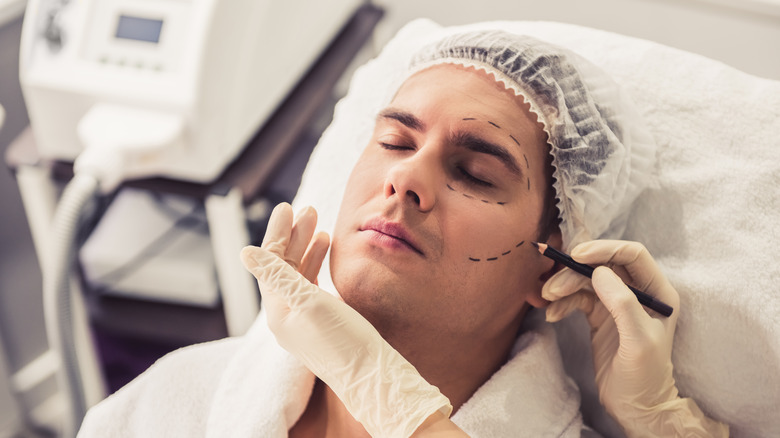Men Are Getting Jaw Surgery To Increase Their 'Manliness,' But Is It An Effective Tactic?
Search online for "cosmetic procedures for men" and the results appear unisex — facelifts, nose jobs, and liposuction draw the attention of many. Still, you'll also encounter a distinctly masculine focus on the jawline. Strong jaws apparently indicate male virility more than other physical features. In fact, one cosmetic practice in New York City, Gotham Plastic Surgery, offers its trademarked "G.I. Jaw," which includes a tailored combination of implants, liposuction, and injectables meant to chisel a person's chin and jawline into a more masculine, militaristic form.
Dr. Erminio Mastroluca of Rome's Studio Medico also identifies the jawline as the key feature designating masculinity and also charisma. "A squared and more prominent chin and a wider jawline ... is central to perceived attractiveness," he and his co-authors stress in a paper published in the Journal of Cosmetic Dermatology. "Moreover, a prominent jawline is often considered to imply 'strength of personality,' and volume loss and skin laxity in this area are frequent aesthetic concerns."
Mastroluca advocates for less-invasive aesthetic procedures to achieve an enhanced jawline, yet there is a more extreme procedure that can presumably provide more robust results for the courageous: jaw surgery.
What jaw surgery is and how it works
Orthognathic surgery can perfect jaw bone irregularities and realign the jaws and teeth to correct the way they work and also to improve facial appearance, according to the Mayo Clinic. But jaw surgery is not for the faint of heart. Essentially, the surgeon cuts into the jaw bones and then moves them into a more optimal position. Bone can be taken away, added, or reshaped. Tiny bone plates, screws, wires, and rubber bands are added to secure the bones into their new place. Over time, these added screws and plates merge to become one with the jaw's architecture.
Jaw surgery can be performed on the upper jaw (known as maxillary osteotomy), lower jaw (mandibular osteotomy), chin (genioplasty), or any combination of these. Often, surgeons will restructure the chin while correcting the jaw. In such cases, the surgeon slices a section of the chin bone, moves it forward, and secures it with plates and screws. Before and after the actual surgery, orthodontics may be needed. In some cases, the entire procedure may take years to complete, though early healing following the surgery itself typically takes about six weeks, with complete healing requiring roughly three months.
Like any operation, jaw surgery is not without risk. In addition to infection and blood loss, possible hazards include nerve injury, pain in the jaw joint, bite fit issues, relapse of the jaw to its original position, and the need for corrective surgeries.
Nailing down the numbers
Certainly, not everyone who undergoes jaw surgery does so for aesthetic reasons. And people of any gender may require this surgery or choose to transform their facial structure. While it is well-known that the majority of cosmetic procedures are done on women, an American Society of Plastic Surgeons national report indicates that 8% of all procedures — a whopping 1.1 million separate cosmetic enhancements — were for men. Estimating the number of men who underwent jaw surgery, though, is difficult. The same national report counts maxillofacial surgeries, an umbrella term for face, jaw, and mouth procedures, and it does not specify the gender breakdown of these operations.
Still, the numbers are staggering. In 2000, just 79,331 maxillofacial surgeries were performed; by 2020, that number had spiked to 256,085 — a 223% uptick in just two decades. Year-over-year, a non-shabby 23% increase occurred in 2020 as the previous year, 2019, saw 207,862 total procedures performed.
Zoom made me do it...?
Delving deeper into scientific surveys, it's clear that aesthetic procedures surged following the pandemic. In fact, more than three-quarters of cosmetic surgery practices reported increased demand for their services in 2022 compared to pre-pandemic levels, according to the American Society of Plastic Surgeons. Pent-up demand during the lockdown contributed to this windfall as did unspent travel money that had accrued in bank accounts. Yet, some believe another factor influenced this trend. Many patients told their doctors they'd only recently begun to feel dissatisfied with their appearance, enough so that they'd risk going under the knife.
Kometh Thawanyarat, a medical student researcher at the Medical College of Georgia, and his co-authors coined the term "Zoom Effect" to explain this recent phenomenon. In a 2021 study, the research team describe how increased use of "video conferencing tools has heightened individuals' awareness of their appearance and has led to increasing appearance-related concerns. For many, this has reaffirmed their interest or desire in aesthetic surgery."
Specifically, their research demonstrated that after February 2020, most of this new interest was focused on above-the-shoulder (as opposed to below-the-shoulder) cosmetic procedures. This suggests that the March 2020 lockdown and resulting plethora of virtual meetings caused many to reassess their faces after spending so much time looking at themselves on Zoom calls.
Risk reward analysis
You may accept that the jawline is crucial to an appearance of masculinity, but it still may not be worth it to you to surgically tamper with this essential feature of your one and only face. After all, will squaring your jaw — by all accounts a painful and risky surgical procedure — get you what you really want?
If attracting a sexual partner is the endgame and your interest is women, then you might do well to heed the words of Benedict C. Jones of the University of Glasgow. His 2018 co-authored study revealed that "women generally preferred masculinized over feminized versions of men's faces, particularly when assessing men's attractiveness for short-term, rather than long-term, relationships." Jones theorizes that masculine characteristics suggest to women strong health (a good thing to pass onto children), but these very same manly traits also imply less willingness to invest time into romantic relationships. Women, then, imagine they'll pay a high price for a masculine man and are wary of selecting one for a long-term partnership.
Bottom line: a strong jawline can certainly attract women. Sadly, though, it may discourage those who want a lasting bond.




